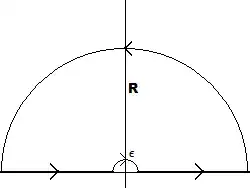Note that with the branch cut along the negative real axis, we see that along the positive real axis
$$(\log(z)-i\pi/2)^2=\log^2(|x|)-i\pi\log(|x|)-\pi^2/4$$
while along the negative real axis
$$(\log(z)-i\pi/2)^2=\log^2(|x|)+i\pi\log(|x|)-\pi^2/4$$
It is easy to show that $\int_{-\infty}^0 \frac{\log^2(|x|)}{1+x^2}\,dx=\int_0^{\infty} \frac{\log^2(|x|)}{1+x^2}\,dx$.
Hence, $\int_{-\infty}^\infty \frac{(\log(x)-i\pi/2)^2}{x^2+1}\,dx=2\int_0^\infty \frac{\log^2(x)}{x^2+1}\,dx-\frac12 \pi^2\int_0^\infty \frac{1}{x^2+1}\,dx$. So, the cross term involving $\log(x)$ is no involved.
Note that had we analyzed $\oint_C \frac{\log^2(z)}{z^2+1}\,dz$, we need to evaluate the integral $\int_0^\infty \frac{\log^2(x)}{x^2+1}\,dx$. However, upon enforcing the substitution $x\to 1/x$, we would readily find that this integral is $0$.
Therefore, we have
$$\begin{align}
\oint_C \frac{(\log(z)-i\pi/2)^2}{z^2+1}\,dz&=2\int_\epsilon^R \frac{\log^2(x)}{x^2+1}\,dx-\frac12\pi^2\underbrace{\int_\epsilon^R \frac{1}{x^2+1}\,dx}_{\to -\pi^3/4\,\text{as}\,\epsilon\to 0\,\text{and}\,R\to\infty}\\\\
&+\underbrace{\int_\pi^0 \frac{\log^2(\epsilon e^{i\phi})}{(\epsilon e^{i\phi})^2+1}\,i\epsilon e^{i\phi}\,d\phi}_{\to 0\,\text{as}\,\epsilon\to 0}+\underbrace{\int_0^\pi \frac{\log^2(R e^{i\phi})}{(R e^{i\phi})^2+1}\,i R e^{i\phi}\,d\phi}_{\to 0\,\text{as}\,R\to \infty}\\\\
&=2\pi i \text{Res}\left(\frac{(\log(z)-i\pi/2)^2}{z^2+1}, z=i\right)\\\\
&=0
\end{align}$$
Note that had we analyzed the integral $\oint_C \frac{\log^2(z)}{z^2+1}\,dz$, the reside would not be zero. However, this poses no significant challenge or complication.
Therefore, as $\epsilon\to 0$ and $R\to \infty$ we see that
$$\int_0^\infty \frac{\log^2(x)}{x^2+1}\,dx=\frac{\pi^3}{8}$$
Although analysis of the integral $\oint_C \frac{(\log(z)-i\pi/2)^2}{z^2+1}\,dz$ facilitates analysis in that we forgo the need to evaluate the integral $\int_0^\infty \frac{\log^2(x)}{x^2+1}\,dx=0$, this does not seem to add any significant benefit of efficiency over analysis of the integral $\oint_C \frac{\log^2(z)}{z^2+1}\,dz$.
